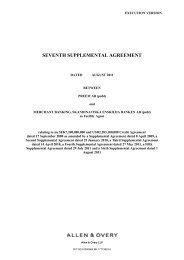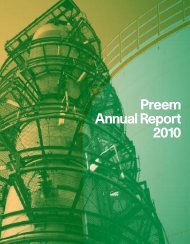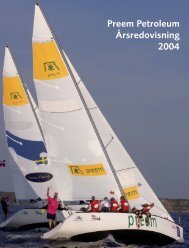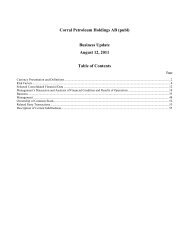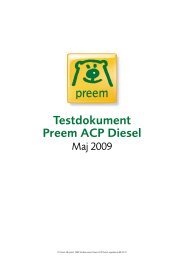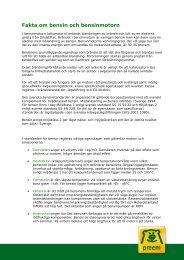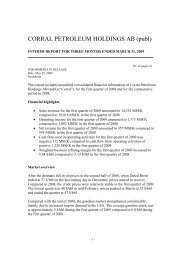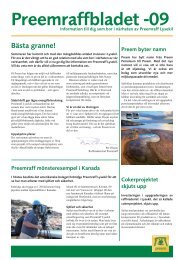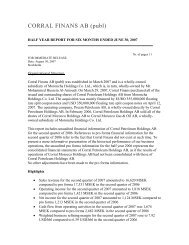CORRAL PETROLEUM HOLDINGS AB (PUBL) - Preem
CORRAL PETROLEUM HOLDINGS AB (PUBL) - Preem
CORRAL PETROLEUM HOLDINGS AB (PUBL) - Preem
Create successful ePaper yourself
Turn your PDF publications into a flip-book with our unique Google optimized e-Paper software.
Emission rights 2010LysekilGothenburgOpening balance, 2010....................................................................................................... 1,393,449 197,198Number of emission rights allocated, 2010.......................................................................... 1,849,176 618,252Number of emission rights consumed 2009 which was cancelled in 2010 .......................... (1,777,932) (496,876)Balances of emission rights as of 31 December 2010....................................................... 1,464,693 318,574Preliminary number of emission rights consumed 2010 which was cancelled in 2011 ....... (1,672,852) (557,239)Total ................................................................................................................................... (208,159) (238,665)Number of emission rights allocated, 2011.......................................................................... 1,849,176 618,252Preliminary balances of emission rights as of 31 March 2011........................................ 1,641,017 379,587Financial assets and liabilitiesFinancial assets are classified in the following categories: financial assets designated at fair value through theprofit (loss) for the year, loans receivable and trade and other receivables designated at accrued cost value, and financialassets held for trading designated at fair value through other comprehensive income (loss). The classification depends onthe purpose for which the financial asset was acquired. Management defines the classification of financial assets whenthey are first recorded.Financial liabilities are classified in the following categories: financial liabilities designated at fair value throughthe profit (loss) for the year, and other financial liabilities.Purchases and sales of financial assets are recorded on the transaction date—the date on which the Groupcommits itself to buy or sell the asset. When first recorded, financial assets and liabilities are recorded at fair value plusor minus any transaction costs if the asset or liability in question is not valued at the fair value according to the profit(loss) for the year. Financial assets are removed from the balance sheet when the right to receive cash flows from theinstrument has expired or been transferred, and the Group has essentially transferred all risks and benefits associated withthe right of ownership. A financial liability or part of a financial liability is removed from the balance sheet when theobligation in the contract has been fulfilled or otherwise cancelled.Financial assets and liabilities designated at fair value through the profit (loss) for the yearFinancial assets and liabilities designated at fair value through the profit (loss) for the year are financial assetsheld for trading. A financial asset or liability is classified in this category if it is acquired primarily with a view to sellingit within a short period of time. Derivatives are classified as being held for trading if they are not identified as hedginginstruments..The Group makes use of oil derivatives that are short-term and are classified in the balance sheet either ascurrent assets or current liabilities under the heading “derivatives” and in the comprehensive income statement under theheading “cost of goods sold” compared to profit (loss) from any other financial instruments that are accounted for withinthe financial net.The Group’s interest rate swaps expired during the year and no new contracts have been concluded. The year’sinfluence from interest rate swaps are recorded in the consolidated comprehensive income statement under the heading“financial expenses.”The Group holds derivatives but does not apply hedge accounting.Loan receivables and trade and other receivablesLoan receivables and trade and other receivables are financial assets that are not derivatives, that have paymentsthat are fixed or can be fixed, and that are not listed in an active market. These items are valued at the accrued cost value.Trade and other receivables are included in current assets when there are no items with a maturity date more than12 months after the balance sheet date. Loan receivables are included in financial non-current assets when the maturitydate is after more than 12 months. The Group’s non-current loan receivables consist primarily of loans to associates.Trade and other receivables are initially recorded at fair value and subsequently at accrued cost value, minus anyreserve for impairment. A reserve for impairment of trade and other receivables is made when there is objective evidencethat the Group will not be able to receive all amounts due according to the original terms and conditions of thereceivables. Indications that a debtor will be declared bankrupt or undergo financial reconstruction and absent or delayedpayments are factors on the basis of which to start impairing a trade or other receivable. The size of a reserve consists ofthe difference between the asset’s carrying amount and the estimated future cash flows. The asset’s carrying amount isreduced by means of an impairment account, and the loss is recorded in the consolidated comprehensive incomestatement depending on the function to which the trade or other receivable relates. When a trade or other receivablecannot be collected, it is written off against the impairment account for trade and other receivables. Any recovery of anF-15



